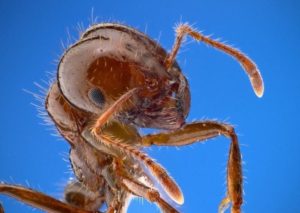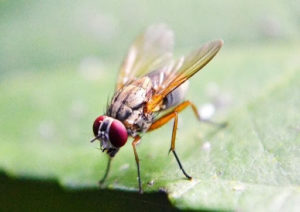How Do I Get Rid of Fire Ants?
This is the second installment in the series. If you want to check out information on chiggers and fleas head over to our last blog post. We are so often asked “how do I get rid of *fill in the blank*?” that we thought it would be useful to write a post on the most common pests we are asked about. This month we look at fire ants, bed bugs and fruit flies/house flies.
How do I get rid of fire ants?
 Fire ants are migratory, so getting rid of fire ants is not a one-shot deal. It requires upkeep to maintain a fire ant-free zone in your yard. Each year, new queens are born. They mate and then fly up to 3 miles, before landing to nest. She feeds off her wings and then burrows below to lay her eggs. In this way new colonies of ants are established constantly when the temperatures are between 70 and 95 degrees.
Fire ants are migratory, so getting rid of fire ants is not a one-shot deal. It requires upkeep to maintain a fire ant-free zone in your yard. Each year, new queens are born. They mate and then fly up to 3 miles, before landing to nest. She feeds off her wings and then burrows below to lay her eggs. In this way new colonies of ants are established constantly when the temperatures are between 70 and 95 degrees.
Many folks are familiar with the fire ant poison you can purchase at large home supply stores. Once spread in your yard it requires watering in. Essentially the water releases the poison into the soil and kills any ants it comes into contact with. The problem with this is that fire ant nests are a little bit like icebergs. What you see above the ground is just a small hint of what lies beneath, and the poison only kills what it contacts.
At Mosquito Joe we prefer a 2-part method to make, and keep, your yard fire ant free. The first requires a bait. Since fire ants share all the food they bring to the nest, and since the queen (and the responsibly party for all the ants in your yard) also feats on the same, a bait will get rid of the source of the problem. The fire ant queen waits 2 days before eating any food brought back. She will only eat once those 2 days have past and the taster ants are still living. To get by this safety measure, we use a bait with a 3-day delay. In this way we can circumvent the safety mechanism she has in place. We combine this treatment with a mound service, designed to kill the population of each nest. Since there is much more going on beneath the ground than above, this must be combined with the bait program to be effective.
Unfortunately, there are no preventative actions you can take to reduce the numbers in your yard. Fire ants are not fussy, and don’t particularly care if your yard is neat or messy, leaf filled or raked. It’s all the same to them.
How do I get rid of bed bugs?


Firstly, we need to dispel the myth that bed bugs are only found in dirty homes. Bed bugs are everywhere – public buildings, schools, gyms, airplanes, in all 50 states and globally. They hitch hike from one place to the next, whether it be in furniture, your gym bag, wild animals, clothing or any number of ways. Just like mosquitoes, bed bugs find their food source through carbon dioxide and are bloodsuckers, feeding of exposed skin, then dropping off and hiding until the next feed (typically in the mattress). The preferred location is the bed as sleeping exposed skin is the easiest meal. While some humans have no reaction to them, the other 80% reacts with small red bumps.
Heat is the enemy of the bed bug, and treatment will include laundering sheets at a high temperature, possibly removing the mattress and disposing (marking it “bed bugs” so the cycle is broken) treating the room and the furniture, box spring, mattress (if you choose to keep it), the air and crevices with heat and insecticides. It is possible to do this yourself, but most people would rather have an expert come in and manage the infestation.
The only prevention is to be alert to their presence, and to take precautions after visiting an infested site. It is advisable to check the bed in a new lodging before taking your suitcase in, and never leave your clothing on the floor. Look for white small eggs and fecal matter in and around furniture, crevices and mattresses. Adults measure 4-5mm long and can be seen with the human eye. It is said that they smell like “rotting raspberries” and trained dogs are able to detect them.
How do I get rid of fruit flies and house flies?


For gnats the easiest remedy, and you should do this twice a year whether you have a problem or not, is to clean your drains. For this you pour about a gallon of bleach into each drain (especially those in a guest bath or shower that gets little use) followed by 10 minutes of hot water. This will flush and clean the drains, preventing new little homes for gnats in your house.
We also often get asked about flies in the yard, which often turn out to be blow flies and house flies. The easiest way to manage these is to manage the stuff they are attracted to. Open trash, pet excrement, and for the blow fly, decaying meat. Mosquito Joe can treat for flies for you, but our treatment is only good when the smell we spray is stronger than the others around it. We place an attractant, coated in pesticide, on the trunk of trees and other areas close enough to your living area to attract them, while far enough away not to be noticed by you. Because scents are short lasting, we recommend the service for a party or outside celebration and always let our customers know that it is not long lasting, and the flies will return in time.
To help yourself in the yard, keep your grass short and your yard tidy. That means keeping up with leaf litter and your pet(s), making sure any compost is far away from your home, and understanding that new mulch and manure will bring them in. The popular suggestion of hanging a bag of water up does not work, in our experience. Homemade fly traps can be helpful, but they can also attract more flies than you otherwise would have.
We hope this series has been useful for you. If you would like us to write on another topic just send us an email with the subject line “blog topic”. For us, pest control is more than killing bugs. It is educating and helping our customers gain a better understanding of how they can help themselves.


